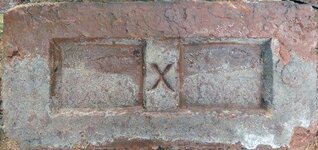Bill D. (VA)
Silver Member
Maker's mark on early colonial brick??
I was going through some of my trash pit finds from the early-to-mid 1600s site where I dug over 20 hammered silver coins a few years back. This is also the same pit where I recovered the c1580-1640 delftware plate this past winter. There were no red bricks found in this pit as I believe the structure was of early posthole construction. But I've found 2 or 3 early Dutch or Flemish bricks in this pit. They are brownish-yellow in color and were some of the rare bricks that were imported to Virginia (as almost all were domestically made). They were used exclusively during the 17th century, and have been found in the Jamestown excavations. They are much smaller than the typical red bricks, and the measurement of mine corresponds exactly with the dimensions given by Hume in his books. One of my bricks has what appears to be some kind of recessed maker's mark containing the "+" symbol. I was wondering what this mark might be, and if it has any significance. I know this is an off-the-wall request, but hopefully someone out there knows more than I do about these bricks and the possible maker's mark. Thanks in advance for any help.


I was going through some of my trash pit finds from the early-to-mid 1600s site where I dug over 20 hammered silver coins a few years back. This is also the same pit where I recovered the c1580-1640 delftware plate this past winter. There were no red bricks found in this pit as I believe the structure was of early posthole construction. But I've found 2 or 3 early Dutch or Flemish bricks in this pit. They are brownish-yellow in color and were some of the rare bricks that were imported to Virginia (as almost all were domestically made). They were used exclusively during the 17th century, and have been found in the Jamestown excavations. They are much smaller than the typical red bricks, and the measurement of mine corresponds exactly with the dimensions given by Hume in his books. One of my bricks has what appears to be some kind of recessed maker's mark containing the "+" symbol. I was wondering what this mark might be, and if it has any significance. I know this is an off-the-wall request, but hopefully someone out there knows more than I do about these bricks and the possible maker's mark. Thanks in advance for any help.


Last edited:









